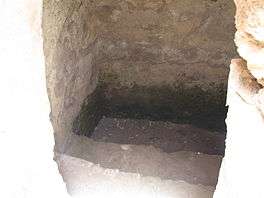Hurvat Itri
| חורבת עתרי | |
|
Archaeological remains at Hurvat Itri | |
| Location |
|
|---|---|
| History | |
| Periods | Second Temple era |
| Site notes | |
| Public access | Open year round |
Coordinates: 31°38′58″N 34°58′19″E / 31.6494720°N 34.9720070°E Hurvat Itri (Hebrew: חורבת עתרי) also known as the Itri Ruins, refers to a sprawling archaeological site that features the remains of Jewish villages, some of which are 2,000 years old. In addition to villages this site includes synagogues, wine presses, theaters, and ritual baths, as well as an underground system of public hiding places. The site is located in modern day Israel and is situated in the Judean Hills, southeast of Bet Shemesh, close to the "Green Line". The site derives its name from the ancient Jewish village of Kfar Atra. The Judean Hills were first settled by the Israelite tribe of Judah during 12th century B.C.E. and then became densely populated by the Jewish people between (1st century B.C.E. – 1st century C.E.). At the time of the Great Revolt (66C.E.-74C.E.) of the Jews against the Roman rulers the Romans took over the hills and destroyed many of the villages and towns. Despite the revolt Jewish people returned and rebuilt their villages. Then came a second revolt also known as the Bar Kochba Revolt which lasted from 132-135 C.E. In which the Jews attacked the Romans using underground tunnels. In the end Jewish population was beaten and their villages and towns were destroyed.[1][2][3]
Gallery
-
Recreation of what some of the structures may have looked like.
-
Archaeological remains.
-

Ancient Jewish Mikveh uncovered at the site.
See also
References
- ↑ JWeekly (28 May 2004). "Raiders of the lost synagogue:Ancient village opens to keep grave robbers away". JWeekly.com.
- ↑ http://books.google.com/books?hl=en&lr=&id=CcjYAQAAQBAJ&oi=fnd&pg=PA191&dq=hurvat+itri&ots=QUiSYlVj7t&sig=9jZc1qxfMwpz6645FwgqS_ZvPuI#v=onepage&q=hurvat%20itri&f=false
- ↑ http://www.dailyjews.com/articles/101_hiking_in_israel.htm
External links
| Wikimedia Commons has media related to Hurvat Itri. |